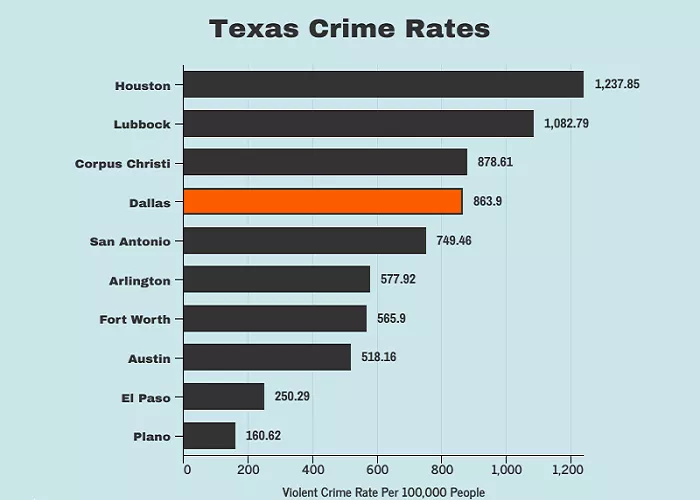Texas is a vast and diverse state, home to bustling urban centers, quiet rural towns, and everything in between. While many cities in Texas are known for their safety and community spirit, others face significant challenges related to crime. Understanding which city has the highest crime rate is essential for residents, potential movers, policymakers, and law enforcement agencies. This article delves into the city in Texas with the worst crime rate, analyzing the contributing factors from various perspectives, including geographical location, culture, economy, and ecology.
What is Crime Rates: Definitions and Metrics
Before identifying the city with the highest crime rate, it’s crucial to understand how crime rates are measured:
- Violent Crime Rate: This includes offenses such as murder, rape, robbery, and aggravated assault.
- Property Crime Rate: This encompasses burglary, larceny-theft, motor vehicle theft, and arson.
- Total Crime Rate: The sum of violent and property crimes, usually expressed per 1,000 residents.
These metrics help provide a standardized way to compare crime levels across different cities, accounting for population differences.
Beaumont: Texas’s Most Dangerous City
According to recent data, Beaumont holds the unfortunate distinction of having the highest crime rate in Texas. With a population of approximately 110,671, Beaumont reported 700 violent crimes and 1,856 property crimes, resulting in a violent crime rate of 6.33 per 1,000 residents.
These figures place Beaumont at the top of the list for violent crimes per capita in the state.
Geographical Analysis
Beaumont is located in Southeast Texas, near the Louisiana border. Its proximity to major transportation routes, including Interstate 10, makes it a significant hub for commerce and travel.
However, this strategic location also presents challenges:
- Drug Trafficking: Being near the Gulf Coast and close to international borders, Beaumont is part of a corridor often used for drug trafficking, which can contribute to higher crime rates.
- Natural Disasters: The area is prone to hurricanes and flooding, leading to economic disruptions and potential increases in crime during recovery periods.
Cultural and Societal Factors
Several cultural and societal elements influence Beaumont’s crime rates:
- Education: Limited access to quality education can lead to higher unemployment and crime rates.
- Community Programs: A lack of community engagement initiatives and youth programs may result in increased juvenile delinquency.
- Law Enforcement Resources: Understaffed or underfunded police departments can struggle to effectively combat crime.
Economic Considerations
Economic factors play a significant role in crime rates:
- Unemployment: High unemployment rates can lead to increased crime as individuals may resort to illegal activities for income.
- Poverty: Areas with high poverty levels often experience higher crime rates due to limited access to resources and opportunities.
- Industrial Decline: Beaumont has faced industrial downturns, leading to job losses and economic instability, which can contribute to higher crime rates.
Ecological and Environmental Factors
Environmental aspects also impact crime rates:
- Urban Planning: Poorly designed urban areas with inadequate lighting and limited public spaces can foster criminal activity.
- Abandoned Properties: Vacant and neglected buildings can become hotspots for illegal activities.
- Pollution and Health Hazards: Environmental health issues can strain community resources and contribute to social unrest.
Comparative Analysis with Other Texas Cities
While Beaumont has the highest violent crime rate per capita, other cities also face significant crime challenges:
- Houston: With a population of over 2.3 million, Houston reported 12,163 violent crimes, resulting in a rate of 5.28 per 1,000 residents.
- Corpus Christi: This city reported a violent crime rate of 4.34 per 1,000 residents.
- Lubbock: With a rate of 4.33 per 1,000 residents, Lubbock also ranks high in violent crimes.
These comparisons highlight that while Beaumont has the highest rate per capita, larger cities like Houston have higher total numbers of crimes.
Community Initiatives and Law Enforcement Efforts
Addressing high crime rates requires a multifaceted approach:
- Community Policing: Building trust between law enforcement and residents can lead to more effective crime prevention.
- Youth Engagement Programs: Providing educational and recreational opportunities for youth can reduce juvenile crime.
- Economic Development: Investing in job creation and economic opportunities can address the root causes of crime.
- Environmental Design: Improving urban infrastructure, such as lighting and public spaces, can deter criminal activity.
Conclusion
Beaumont, Texas, currently holds the highest violent crime rate per capita in the state. Various factors, including its geographical location, economic challenges, cultural dynamics, and environmental conditions, contribute to this status. Addressing these issues requires comprehensive strategies involving community engagement, economic investment, and effective law enforcement. By understanding and tackling the underlying causes, Beaumont can work towards creating a safer environment for its residents.

